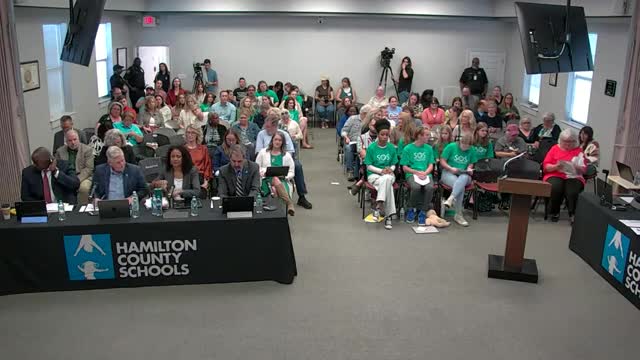Hamilton County presents 'Every Student Learns' 2030 update; district shows mixed gains and flags middle-school literacy
October 10, 2025 | Hamilton County, School Districts, Tennessee
This article was created by AI summarizing key points discussed. AI makes mistakes, so for full details and context, please refer to the video of the full meeting. Please report any errors so we can fix them. Report an error »

District staff presented the Hamilton County Schools quarterly update on the district goal “Every Student Learns,” reviewing achievement and growth metrics and planned interventions.
Dr. Blake Freeman, the district's chief academic leader, reported the district's composite growth score for 2024–25 as a Level 3, which the district described as meeting expectations. He said subject-level achievement rose in several areas year over year and that science and social studies showed above-expectation growth in parts of the district.
The presentation called out disparities by grade band. Middle-school ELA growth drew specific concern; Dr. Freeman said middle grades are the primary driver of lower districtwide ELA growth, noting middle-school ELA growth was rated lower than elementary and high school performance. In kindergarten through second grade the district reported a new baseline for a state-required screener: in fall 2024–25, about 25.2% of K–2 students scored below the 25th percentile on the new screener, a change staff said reflects a state switch of screening instruments and cannot be directly compared with previous-year data.
Targets and context: the update compared outcomes to the district's Opportunity 2030 targets. Dr. Freeman said the district outpaced some Opportunity 2030 year-2 targets overall — for example, the combined “all students” metric reported 42.4% meeting or exceeding state assessments, above the stated Opportunity 2030 year-2 target of 37.9% — while other groups (economically disadvantaged students and students with disabilities) remained below their respective Opportunity 2030 targets.
Action steps and supports: staff described multiple action sets to address gaps, including a Tier 1 instruction emphasis to ensure grade-level texts and tasks, expanded early-literacy (science-of-reading) work for K–2 and literacy through grade 5, targeted middle-school math professional learning and learning labs, “sustain and extend” mastery plans to support students at different performance levels, ACT curriculum supports for high school students, and continued RTI (response-to-intervention) practices. Dr. Freeman said the district is continuing implementation of a recently adopted science curriculum and is expanding supports for the sixth- to ninth-grade transition.
Questions from board members focused on what drove particular gains: staff attributed social-studies gains in part to curriculum resources and a partnership using iCivics materials, and said math improvement reflects the second year of a new math adoption combined with targeted supports for middle grades.
Ending: district leaders said they will return with more data later in the year, including a December report on the “Every Student Belongs” goal. No formal board action on the metrics was recorded in the meeting transcript.
Dr. Blake Freeman, the district's chief academic leader, reported the district's composite growth score for 2024–25 as a Level 3, which the district described as meeting expectations. He said subject-level achievement rose in several areas year over year and that science and social studies showed above-expectation growth in parts of the district.
The presentation called out disparities by grade band. Middle-school ELA growth drew specific concern; Dr. Freeman said middle grades are the primary driver of lower districtwide ELA growth, noting middle-school ELA growth was rated lower than elementary and high school performance. In kindergarten through second grade the district reported a new baseline for a state-required screener: in fall 2024–25, about 25.2% of K–2 students scored below the 25th percentile on the new screener, a change staff said reflects a state switch of screening instruments and cannot be directly compared with previous-year data.
Targets and context: the update compared outcomes to the district's Opportunity 2030 targets. Dr. Freeman said the district outpaced some Opportunity 2030 year-2 targets overall — for example, the combined “all students” metric reported 42.4% meeting or exceeding state assessments, above the stated Opportunity 2030 year-2 target of 37.9% — while other groups (economically disadvantaged students and students with disabilities) remained below their respective Opportunity 2030 targets.
Action steps and supports: staff described multiple action sets to address gaps, including a Tier 1 instruction emphasis to ensure grade-level texts and tasks, expanded early-literacy (science-of-reading) work for K–2 and literacy through grade 5, targeted middle-school math professional learning and learning labs, “sustain and extend” mastery plans to support students at different performance levels, ACT curriculum supports for high school students, and continued RTI (response-to-intervention) practices. Dr. Freeman said the district is continuing implementation of a recently adopted science curriculum and is expanding supports for the sixth- to ninth-grade transition.
Questions from board members focused on what drove particular gains: staff attributed social-studies gains in part to curriculum resources and a partnership using iCivics materials, and said math improvement reflects the second year of a new math adoption combined with targeted supports for middle grades.
Ending: district leaders said they will return with more data later in the year, including a December report on the “Every Student Belongs” goal. No formal board action on the metrics was recorded in the meeting transcript.
View full meeting
This article is based on a recent meeting—watch the full video and explore the complete transcript for deeper insights into the discussion.
View full meeting
